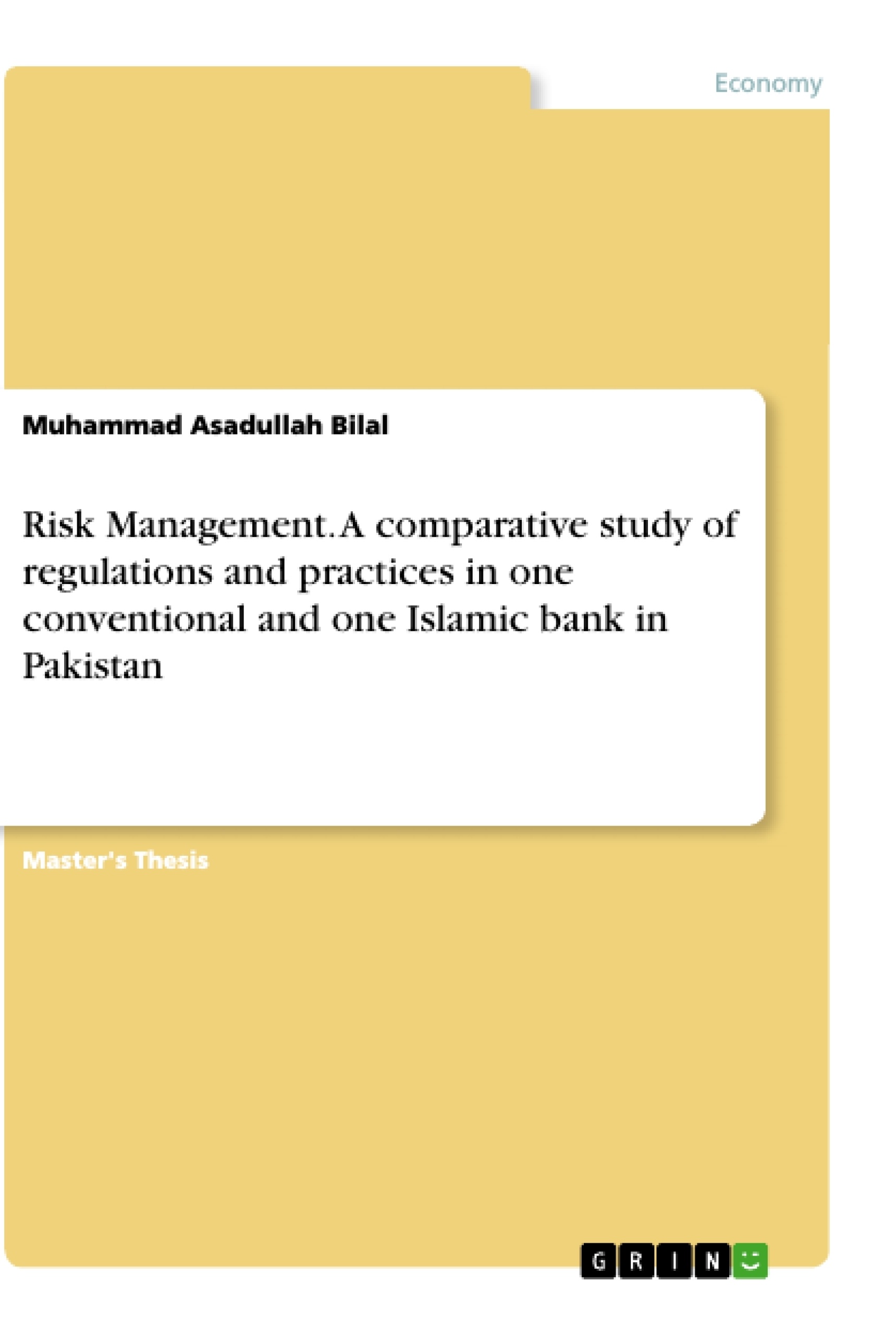The purpose of this research study is to figure out the differences in rules/regulations and practices regarding risk management in Islamic and conventional banks in Pakistan. Keeping in view the research questions, the nature of this research is a qualitative case study. The findings of the study reveal that there exists a substantial difference between Islamic and conventional banks in risk management practices, risk identification, liquidity risk analysis and risk governance. Islamic bank is performing competently in liquidity risk analysis, whereas, conventional bank is competent in risk management practice, risk identification, and risk governance.
The risk management, risk monitoring and reporting, and liquidity risk analysis are weak in Islamic banks. Whereas, risk analysis and assessment are weak in conventional banks. Due to lack of risk management training and limited knowledge of risk management practices, understanding of risk management practices is weak in Islamic bank. The study also reveals that in terms of rules and regulations, there is no proper institutionalisation of Islamic institutions regarding risk management as compared to conventional banking where the risk management practices are institutionalised by Basel Committee on Banking Supervision.
Inhaltsverzeichnis (Table of Contents)
- Chapter 1. Introduction
- 1.1 Background and Motivation
- 1.2 Problem Statement
- 1.3 Research Questions
- 1.4 Aims and Objectives of the Study
- 1.5 Research Outline
- Chapter 2. Theoretical Framework
- 2.1 Institutional Theory
- 2.2 Stakeholder Theory
- 2.3 Agency Theory
- Chapter 3. Conceptual Model
- Chapter 4. Literature Review
- 4.1 Risk
- 4.2 Risk Management
- 4.3 Risk Management Process
- 4.4 Operational Risk Management
- 4.5 Effective Risk Management
- 4.6 Types of Risk
- 4.7 State Bank of Pakistan Guidelines
- 4.8 Basel III Guidelines
- 4.9 Existing Literature
- 4.10 Literature Gap
- Chapter 5. Methodology
- 5.1 Data Collection
- 5.2 Transcription
- Chapter 6. Findings
- 6.1 Interview 1(Islamic Bank)
- 6.1.1 Part I (Risk Management Practices)
- 6.1.2 Part II (Rules and Regulations)
- 6.1.3 Part III (Major Risks)
- 6.2 Interview 2 (Conventional Bank)
- 6.2.1 Part I (Risk Management Practices)
- 6.2.2 Part II (Rules and Regulations)
- 6.2.3 Part III (Major Risks)
- Chapter 7. Analysis and Discussion
- 7.1 Risk Management Practices
- 7.1.1 Credit Risk Management
- 7.1.2 Liquidity Risk Management
- 7.1.3 Operational Risk Management
- 7.1.4 Market Risk Management
- 7.1.5 Risk Mitigation
- 7.2 Risk Management Rules and Regulations
- 7.3 Major Risks
Zielsetzung und Themenschwerpunkte (Objectives and Key Themes)
This research study aims to identify and analyze the differences in rules, regulations, and practices concerning risk management in Islamic and conventional banks in Pakistan. The study utilizes a qualitative case study methodology by examining the practices of one Islamic and one conventional bank in Pakistan.
- Comparative analysis of risk management practices in Islamic and conventional banks.
- Examination of differences in risk identification, liquidity risk analysis, and risk governance between Islamic and conventional banks.
- Evaluation of the strengths and weaknesses of risk management systems in both types of banks.
- Assessment of the impact of regulatory frameworks (Basel III and State Bank of Pakistan guidelines) on risk management practices.
- Exploration of the challenges and opportunities for effective risk management in Islamic and conventional banks in Pakistan.
Zusammenfassung der Kapitel (Chapter Summaries)
The study begins by outlining the background and motivation behind the research. It emphasizes the importance of risk management in financial institutions, especially in the context of the 2008 financial crisis. The chapter also defines the problem statement, research questions, aims and objectives, and research outline. The second chapter delves into the theoretical framework by presenting relevant theories such as Institutional Theory, Stakeholder Theory, and Agency Theory. These theories provide a foundation for understanding risk management practices in financial institutions.
Chapter three presents the conceptual model used in the research. Chapter four, titled "Literature Review," provides a comprehensive overview of risk management concepts, practices, and the existing literature on the subject. The chapter discusses different types of risks, the risk management process, and the role of regulatory frameworks like Basel III and the State Bank of Pakistan guidelines. It also highlights the existing literature gap that the current research aims to address.
Chapter five details the methodology employed in the research. The chapter describes the data collection methods used, including semi-structured interviews with representatives from the chosen Islamic and conventional banks. The chapter also explains the data analysis techniques employed in the study. Chapter six presents the findings of the research based on the interviews conducted with both the Islamic and conventional banks. It details the specific practices, rules, and regulations concerning risk management, and highlights the major risks identified in each type of institution.
Chapter seven analyzes and discusses the findings presented in chapter six. It compares and contrasts the risk management practices, rules, and regulations in Islamic and conventional banks. The chapter examines the strengths and weaknesses of each bank type in areas such as credit risk management, liquidity risk management, operational risk management, and market risk management.
Schlüsselwörter (Keywords)
The main keywords and focus topics of this study include: risk management, Islamic banking, conventional banking, Pakistan, risk identification, liquidity risk analysis, risk governance, Basel III guidelines, State Bank of Pakistan guidelines, comparative analysis, qualitative case study, financial institutions, regulatory frameworks. The study emphasizes the differences in risk management practices and regulations between Islamic and conventional banks in Pakistan, drawing upon theoretical frameworks and empirical findings to shed light on the key issues.
- Quote paper
- Muhammad Asadullah Bilal (Author), 2018, Risk Management. A comparative study of regulations and practices in one conventional and one Islamic bank in Pakistan, Munich, GRIN Verlag, https://www.grin.com/document/513488



